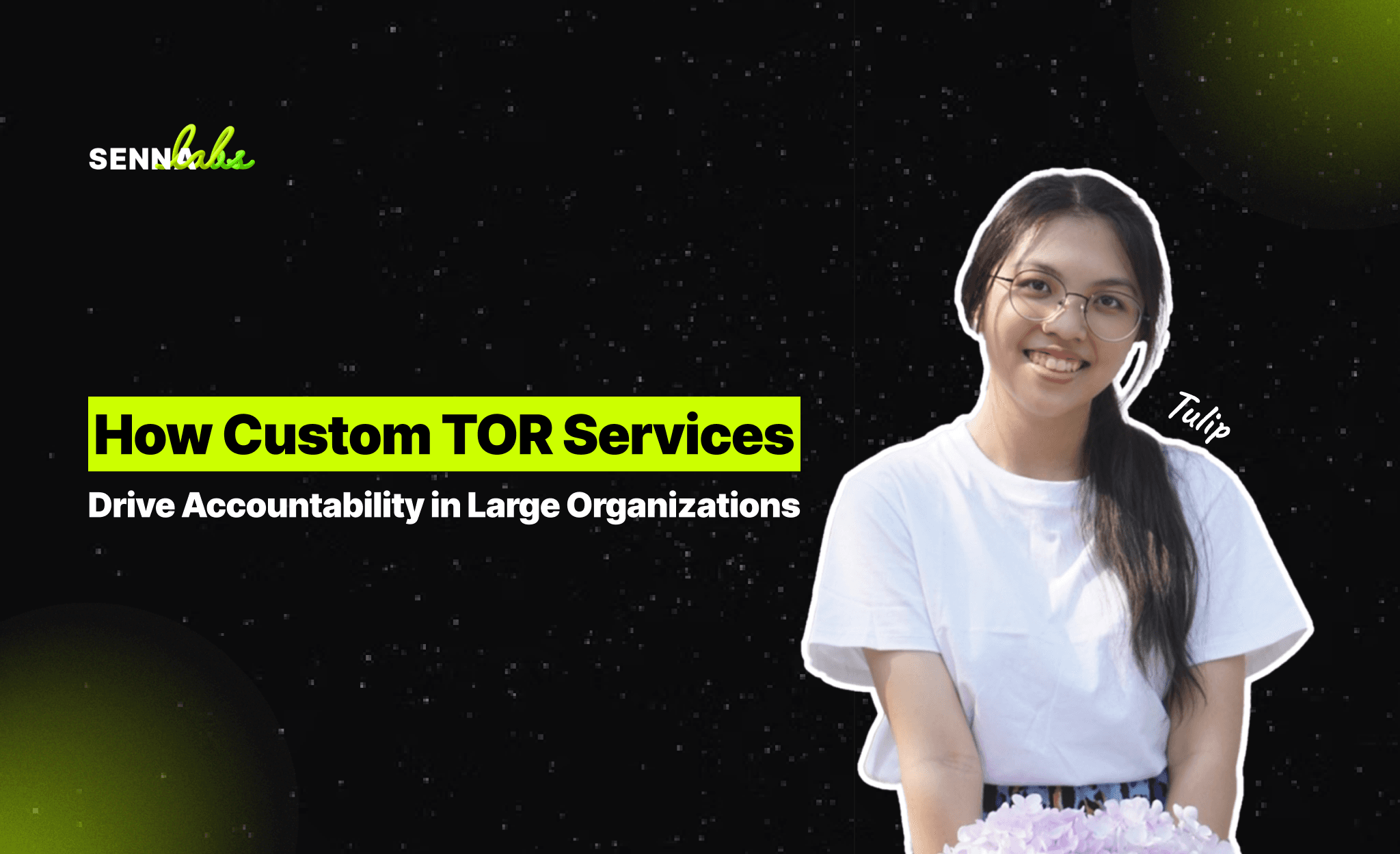How Custom TOR Services Drive Accountability in Large Organizations
Share

In large organizations, particularly those managing complex projects or operations, clarity and accountability are essential for ensuring that objectives are met efficiently and effectively. One of the most powerful tools available to drive accountability and clarity across teams is a well-structured Terms of Reference (TOR) document. A customized TOR is specifically tailored to meet the unique needs of an organization and its projects, ensuring that roles, responsibilities, and expectations are clearly defined.
When roles are not well-defined, especially in large organizations, communication breakdowns occur, accountability diminishes, and project delays become inevitable. Customized TOR services can solve these challenges by establishing clear boundaries and roles for each team, eliminating ambiguity, and fostering a culture of responsibility. In this article, we will explore how custom TOR services help drive accountability in large organizations and enhance project success.
Additionally, we will present a use case where a large government department used custom TOR services to clarify the roles of various teams working on a national infrastructure project. The result was a 25% increase in project efficiency due to reduced communication breakdowns and improved accountability.

What Are Terms of Reference (TOR)?
A Terms of Reference (TOR) is a formal document that outlines the scope, objectives, responsibilities, and expectations of a project or operation. In large organizations, TOR documents are often used to ensure that all stakeholders have a clear understanding of their roles and duties. A well-crafted TOR can act as a roadmap that guides projects from inception to completion, ensuring that all tasks are carried out according to plan.
Key Elements of a TOR Document:
-
Project Scope: Defines the boundaries of the project, including the objectives, deliverables, and specific tasks to be accomplished.
-
Roles and Responsibilities: Clarifies who is responsible for each part of the project, from leadership roles to individual team members’ tasks.
-
Timelines: Establishes deadlines for major milestones and the final delivery of the project.
-
Resources and Budget: Specifies the resources (financial, personnel, or technical) that will be allocated for the project and how they will be managed.
-
Performance Metrics: Outlines the key performance indicators (KPIs) and criteria that will be used to measure success.
-
Communication Plan: Sets up a framework for how information will be shared and communicated across teams.
While standard TOR templates exist, the complexity and scale of large organizations and their projects often require more than a generic solution. This is where customized TOR services become critical.
The Role of Custom TOR Services in Large Organizations
Large organizations face unique challenges when it comes to managing multiple teams and complex projects. A generic TOR may not account for the intricacies and specific needs of these projects, which can lead to ambiguity in roles, miscommunication, and a lack of accountability. Custom TOR services offer tailored solutions that address these challenges by focusing on the specific goals, risks, and resources of each project.
1. Clarity in Roles and Responsibilities
One of the most significant benefits of a customized TOR is that it provides crystal-clear definitions of roles and responsibilities. In large organizations, multiple departments and teams often work on the same project, and without clarity, confusion and overlap of duties can arise. A custom TOR specifies who is responsible for what, removing ambiguity and ensuring that all team members know their roles.
Why This Drives Accountability: When responsibilities are explicitly stated, it becomes easier to hold individuals and teams accountable for their tasks. Each person knows their role in the broader project and what they are expected to deliver. When accountability is clear, teams are more motivated to meet their objectives, and project oversight is simplified.
2. Enhanced Communication and Collaboration
Large organizations often struggle with communication silos, where teams or departments fail to share critical information with one another. This breakdown in communication can lead to delays, mistakes, and even project failure. A customized TOR outlines a clear communication strategy, including how and when updates should be shared, which stakeholders are involved in decision-making, and how to escalate issues.
Why This Drives Accountability: With a clearly defined communication plan, misunderstandings are reduced, and teams are more likely to collaborate effectively. When communication protocols are followed, it ensures that all relevant parties are informed, which in turn fosters accountability. When teams are aware of how their work fits into the larger project, they take ownership of their responsibilities, knowing that their performance impacts other teams and the project's success.
3. Specific Performance Metrics and KPIs
A customized TOR helps define performance metrics and key performance indicators (KPIs) specific to the project. These metrics allow management to track progress and measure success. In large organizations, it can be easy for teams to lose sight of their goals, particularly when projects span long periods or involve multiple departments. Custom TORs ensure that every team knows the performance standards they are expected to meet.
Why This Drives Accountability: By establishing clear KPIs, teams can be regularly assessed based on their performance. This fosters accountability because it creates an objective way to measure success or failure. When teams know they are being evaluated against specific metrics, they are more likely to stay focused on their tasks and strive to meet or exceed expectations.
4. Improved Resource Management
Managing resources effectively in large organizations can be challenging, especially when multiple teams require access to the same resources. A custom TOR provides a detailed breakdown of how resources will be allocated, ensuring that each team has what it needs to complete its work. This includes financial resources, personnel, and technical tools.
Why This Drives Accountability: When resource allocation is clearly defined, teams can be held accountable for how they use their assigned resources. It also helps prevent delays caused by resource shortages or misallocation. If a project goes off track due to poor resource management, it’s easy to identify which team or department needs to address the issue, allowing for swift corrective action.
5. Defined Risk Management Procedures
Large projects come with their fair share of risks, from operational risks to budgetary concerns. A custom TOR allows for a detailed risk management plan, specifying how potential risks will be identified, assessed, and mitigated. By outlining these procedures, the TOR helps ensure that all teams are prepared to deal with issues as they arise.
Why This Drives Accountability: When risk management responsibilities are clearly assigned, teams can be held accountable for implementing preventive measures and addressing risks when they occur. This prevents blame-shifting and ensures that problems are dealt with efficiently, reducing the overall impact on the project.
6. Built-In Flexibility for Adaptation
Complex projects are rarely static; they evolve as circumstances change. Custom TOR services allow for built-in flexibility, enabling teams to adjust to changes in project scope, resource availability, or timelines without losing sight of the overall objectives. This adaptability is especially important for large organizations that often face shifting priorities or external factors that impact project delivery.
Why This Drives Accountability: Having the flexibility to adapt to changing conditions does not negate accountability. Instead, it ensures that teams can remain accountable even when the project direction shifts. Teams know that changes in the project will be managed within a structured framework, and their responsibilities will be updated accordingly.
Use Case: A Government Department Improves Accountability Through Custom TOR
To illustrate the power of custom TOR services in driving accountability, let’s look at a real-world example of a large government department managing a national infrastructure project.
The Challenge:
The government department was responsible for overseeing the development of a major national infrastructure project, involving several internal teams and external contractors. However, they were facing frequent communication breakdowns and issues with unclear roles, which were causing delays and increasing costs. Different teams were unsure of their responsibilities, and key decisions were often delayed due to miscommunication. As a result, the project was running behind schedule, and costs were spiraling.
The Solution:
Recognizing the need for clarity, the department implemented custom TOR services to define the roles and responsibilities of each team involved in the project. The TOR was specifically tailored to the complexity of the project, taking into account the various internal departments, contractors, and external stakeholders.
The custom TOR provided:
-
Clear Definitions of Roles: Each department and contractor was assigned specific tasks, with no overlap in responsibilities. This made it easy to track progress and hold teams accountable for their deliverables.
-
Improved Communication Channels: A communication plan was established, outlining how progress would be reported and how issues would be escalated. This ensured that all teams were regularly updated, and key decisions were made in a timely manner.
-
Defined Performance Metrics: Specific KPIs were set for each phase of the project, allowing the department to track progress and make adjustments as needed.
The Results:
The impact of the custom TOR services was significant:
-
25% Increase in Project Efficiency: With roles and responsibilities clearly defined, there were fewer communication breakdowns, and teams were able to work more efficiently.
-
Improved Accountability: Each team knew exactly what was expected of them, and progress was tracked against specific performance metrics. As a result, there was less duplication of effort, and teams took greater ownership of their work.
-
Faster Decision-Making: The improved communication channels ensured that issues were addressed quickly, and key decisions were made without delays.
Conclusion
In large organizations, particularly those managing complex projects, accountability is critical to ensuring that objectives are met on time and within budget. A customized Terms of Reference (TOR) is one of the most effective tools available to drive accountability by clarifying roles, improving communication, and establishing performance metrics.
As seen in the use case of the government department managing a national infrastructure project, custom TOR services can lead to significant improvements in project efficiency and accountability. By tailoring the TOR to the specific needs of the project, organizations can ensure that all teams are aligned with the project’s objectives and held accountable for their deliverables.
For large organizations looking to enhance accountability and improve project outcomes, investing in custom TOR services is a strategic move that will pay dividends in the long run.

Share

Keep me postedto follow product news, latest in technology, solutions, and updates
Related articles
Explore all


